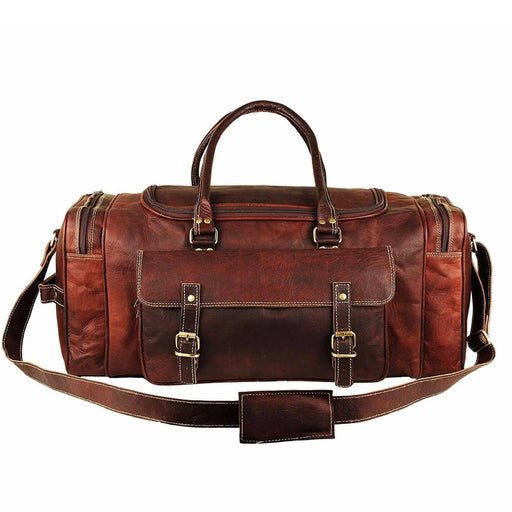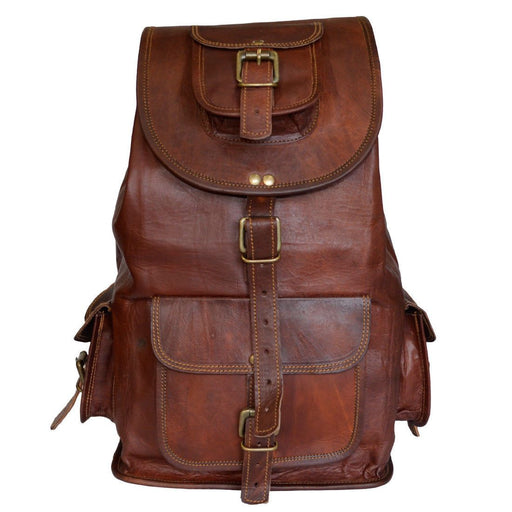
Understanding How Leather Bag Manufacturers Are Going Green
Introduction to How Leather Bag Manufacturers Are Going Green
Do you know what one trend will gain momentum in 2025? It’s a sustainable lifestyle. Eco-friendly fashion is one major aspect of this lifestyle. More and more people are making environmentally sound fashion choices—from repeating clothes to promoting thrift shopping to purchasing eco-friendly leather bags. The circular fashion is going to see an upward trajectory in 2025 and the coming years. Because of the change in consumer behavior, leather brands are adopting eco-friendly practices to manufacture leather bags.
If adopting a sustainable lifestyle is your 2025 resolution and you’re a die-hard fan of leather bags, then this blog is for you. From the use of eco-friendly dyes and finishes in leather bags to recycling and upcycling and eco-conscious packaging, let’s understand how leather bag manufacturers are going green. But before that, it’s important to analyze the importance of eco-friendly leather bag manufacturers in 2025 and the coming years.
Importance of Eco-Friendly Leather Bag Manufacturers

For time immemorial, the leather bag industry has been characterized by the use of chemicals in the tanning process that degrade the quality of soil and water in the region. Moreover, the extensive water usage and non-treatment of wastewater further imbalances the water ecosystem.
In the face of customers becoming conscious about the impact of their lifestyle on climate and environmental pollution, you can see the emergence of eco-friendly leather bag manufacturers around you.
The adoption of sustainable practices by brands to manufacture eco-friendly leather bags is turning out to be a game-changer in many ways:
1. Prevent Soil Contamination: Earlier chrome tanning process was used to treat the skin and manufacture leather bags. This process involves the use of non-biodegradable chemicals like chromium salts. The harsh chemicals used to seep into the soil, thus degrading its quality and leading to soil contamination.
Now leather bag manufacturers are switching to vegetable tanning process. In this process, the natural tannins derived from plants are used to treat the skin to produce leather. Though this process is long and complex, it’s eco-friendly and biodegradable. This process not only produces premium and distinct leather bags but also minimizes the impact on the environment and planet.
2. Treat Waste Management: Earlier the leather bag manufacturers used to leave the waste generated from leather bag manufacturing untreated and unmanaged. As a result, every type of waste material was dumped into landfills, thus causing environmental degradation.
Since leather bag manufacturing is also water-intensive, the non-deployment of water reuse practices or recycling methods caused water pollution. Today, time has changed. As more and more people are becoming eco-conscious and making thoughtful fashion choices, leather bag manufacturers are becoming conscious too.
They understand that minimizing water usage is an integral part of manufacturing eco-friendly bags. They are employing comprehensive waste management systems for reusing and recycling wastewater. They are moving towards zero-waste production by recycling leather scraps and adopting circular economy practices.
3. Reducing Greenhouse Gas Footprint with Energy-Efficient Systems
Leather bag manufacturing is energy-intensive, and marked with a high greenhouse gas footprint.
Today, leather bag brands are adopting state-of-the-art technologies and methods to produce sustainable leather duffle bags and other accessories. Additionally, brands are employing renewable energy sources to power leather bag manufacturing operations.
The energy-efficient machinery and renewable sources are not only reducing the carbon footprint but are also producing high-quality leather bags without compromising on style and functionality.
The Use of Eco-Friendly Dyes and Finishes in Leather Bags

Dyes play a key role in giving fresh and distinct appearance to the leather bags. It is the magic of dyes that gives a glossy touch to women’s clutch wallets or a tan color to messenger bags. However, the conventional leather dyeing process involved the use of harsh chemicals to enhance the appearance of leather bags. These chemicals hurt the environment as they cause water pollution and leave behind hazardous waste.
As a part of becoming a sustainable leather brand, many manufacturers have started the use of eco-friendly dyes and finishes in leather bags, while maintaining the quality, luxurious appeal, and elegance of the leather accessories.
Popular Sustainable Leather Dyes:
1. Natural Dyes: Leather bag brands use natural dyes that are derived from insects and plants. These dyes are non-toxic in nature, thus they are safe for the environment. They add a natural color to the bags. Thus, giving them a unique appearance.
2. Waterless Dyes: They are a great sustainable alternative to conventional dyes that use a lot of water to dye bags. Today, bag manufacturers are using waterless dry wax dye to color leather sling bags, tote bags, and laptop bags. Therefore, there is a reduction in water consumption and wastewater. These environment-friendly and biodegradable dyes maintain the quality of leather bags and also add depth to them.
Smart Technologies Adding Finish to Eco-Friendly Leather Bags

There is not only the adoption of eco-friendly dyes to reduce the environmental impact of leather production. There has been an integration of sustainable methods for almost every step in leather bag manufacturing. Brands are incorporating advanced technologies for designing and finishing leather bags. These technologies aim to reduce waste generation as well as manufacturing time.
1. Digital Printing: The traces of digitalization can be found in the leather industry too. Many leather bag manufacturers have started using digital printing technology to create neat and detailed designs. This technology is not only creating more personalized designs but also reducing waste generation and water consumption.
2. Laser Cutting Technology: This technology is bringing a revolution in the fashion industry by improving craftsmanship. It provides incredible precision to men’s leather wallets and bags by carving out intricate patterns. This technological upgrade is improving production efficiency and also reducing carbon footprint.
Recycling and Upcycling: How Manufacturers Are Reducing Leather Waste

1. Recycling Leather:
Recycling leather means using discarded solid leather waste to create new and high-quality leather bags like Leather backpacks, totes, etc. The process of manufacturing a leather bag generates a lot of solid leather scraps. Earlier the manufacturers left the waste untreated which contributed to environmental pollution. Today, they are adopting modern technologies to create new and stylish leather bags from waste.
Their innovative approach is based on transforming discarded leather scraps into high-quality and full-grain leather bags, thus ensuring the smart utilization of leather waste scraps. Additionally, it is a cost-saving affair for the manufacturers as a new product is manufactured from discarded pieces.
2. Upcycling Leather:
Upcycling leather means creatively reusing old and unused leather accessories to create stylish and functional leather products. It’s like giving a new look and fresh appeal to the existing leather products. Upcycling gives a personal and creative touch to old leather accessories while maintaining the natural beauty of the leather.
3. Upcycling Tip:
Give a new and dramatic look to the old leather sling bag by twilling a scarf around the straps. It is one of the easiest ways to refresh the look of an old bag.
Benefits of Recycling and Upcycling Leather:

1. Reduced Carbon and Environmental Footprint: The energy-saving practices of upcycling and recycling reduce the need for new raw leather to manufacture new sustainable leather bags. They minimize the use of chemicals and reduce waste generation.
2. Optimal Utilization of Resources: Each new recycled bag and upcycled leather jacket is produced from the existing leather. Therefore, there is efficient utilization of leather resources to manufacture new accessories.
3. Contributes to Circular Economy: Implementation of recycling and upcycling practices extend the life of existing leather. These strategies promote a circular economy in the leather industry.
Eco-Conscious Packaging: How Leather Bag Brands Are Going Green Beyond the Product

Leather bag manufacturers are adopting sustainable practices beyond product manufacturing. They are using eco-friendly packaging to further contribute to environmental protection.
1. Reusable Packaging: Leather bag manufacturers are opting for sustainable packaging that can be reused or recycled for different purposes. Reusable packaging ensures that packaging material doesn’t find its way into landfills. It reduces soil pollution and ensures the efficient utilization of resources.
2. Biodegradable Packaging: Leather brands are minimizing their carbon footprint with biodegradable packaging. In this, the packaging is made from organic materials, thus it goes through a process where material breaks down naturally and is consumed by microorganisms. So biodegradable packaging leaves behind no hazardous residue. Such type of packaging is practical and environment-friendly.
3. Bio-Plastic Packaging: Bio-plastic packaging is another eco-conscious solution adopted by many leather bag manufacturers. It is a great alternative to non-biodegradable plastic packaging. In this, the bio-plastic is manufactured from sugarcane or other renewable resources. Bio-plastic packaging attains the same durability and flexibility as that of plastic. It is biodegradable, thus reducing the greenhouse gas footprint.
Also Read: How to Care For Your Leather Bags?
The Final Words
For a long period, leather bag manufacturing has been characterized by resource-intensive processes, that cause soil pollution and disturb the ecological balance. As consumers are switching towards sustainable shopping, leather bag manufacturers are adopting different strategies and employing the best practices to manufacture green yet aesthetic leather bags.
The brands are striving to manufacture eco-friendly leather accessories that not only exude class and luxury but also reduce the carbon footprint.
Leather Bags for Men
Walker Leather Office Travel Bag
The super-stylish Walker leather unisex duffle bag is undoubtedly a trendsetter all year. This opulent, oblong weekender bag is made...
View full detailsTraveler Weekender Duffle Bag
This is the perfect solution for all your needs. This leather duffle bag has four big pockets on the exterior with two buckles. This...
View full detailsSpencer Hiking Backpack
The Spencer Leather Backpack is the perfect bag for all your adventures because it is designed to hold everything you need for a trip. Wit...
View full detailsWindsor Crossbody Bag
This unique brown leather crossbody bag for men and women will make every outfit of yours stand out effortlessly. This sling bag is handcrafted by ...
View full detailsCambridge Leather Satchel Bag
This handcrafted Cambridge Leather Satchel Bag is an exclusive product of MaheTri's Satchels collection for men and women. At MaheTri's leather ...
View full details




